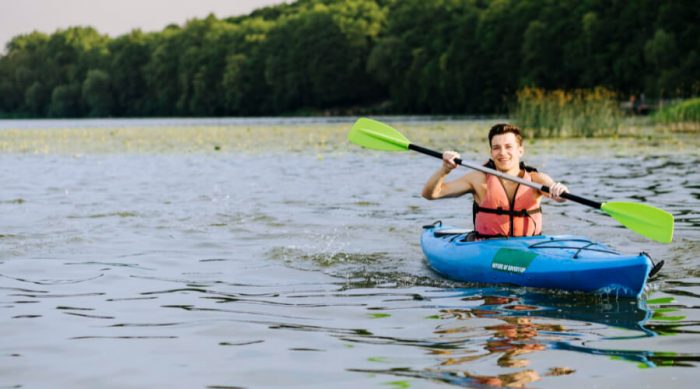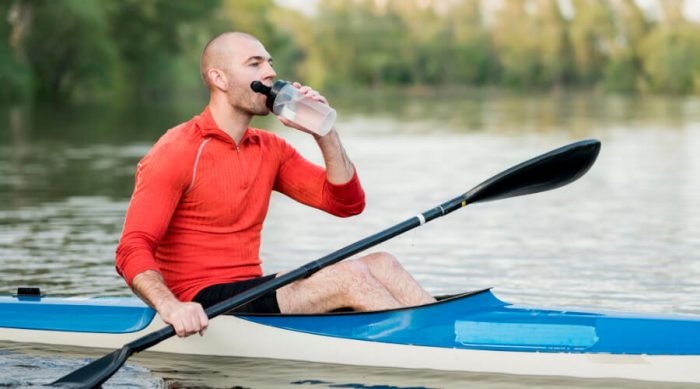If you want to kayak alone, you need to be confident in your paddling and self-recovery skills. Practice solo landing and launching before your trip to be sure you can re-enter the kayak if you fall out. Also, ensure you have all the equipment you need to be safe.
Key Takeaways
- Kayaking alone is fun but it is also riskier because you are on your own in case something happens
- While kayaking alone you have to ensure that you are wearing the right type of clothes depending on the weather to avoid problems
- While solo kayaking, you must bring some tools with you like a bilge pump to remove any water that enters your cockpit with ease
- You must have a coastguard-approved PFD while kayaking alone
- You will need different navigation tools such as a map, compass, or GPS device for a solo kayaking trip
Ten Things You Should Have When Kayaking Alone

This section takes you through the equipment and gear that you need to have before you go kayaking alone. All these things will guarantee your safety and a fun adventure. Let’s get into it.
1. Good Quality And Reliable Kayak– you can choose to hire or buy one; hiring gives you numerous options to choose from while buying saves you money in the long run. Choose what works for you and get an excellent stable kayak.
2. Right Size Paddle
3. Bilge Pump- this helps you get any water that enters your cockpit out with ease. A bilge pump is a great accessory that you will never regret having.
4. Proper Clothing For The Weather- your kayaking gear should be nonbinding and non-cotton. On warmer days, you can wear swimwear or shorts with a rash guard top, while on cold days, wetsuits are best. Some neoprene footwear will also come in handy to protect your feet and keep them dry.
5. Personal Floatation Device- ensure you have a coastguard-approved PFD that fits well. This helps you stay afloat in case of capsizing.
6. Navigation Tools- depending on where you are going and how long your trip is, you will need different navigation tools such as a map, compass, or GPS device. You also need navigation skills, and we recommend starting with familiar routes where you can get back home with ease
7. Signaling Whistle, Mobile Phone, Or Flare Gun- these are essential to help you call for help in case of an emergency
8. Watch- to help you keep in touch with how much time you have to get back and Headlamp plus extra batteries in case you get back late
9. Water And Light Snacks- ensure your stomach is complete when you head out to the water and carry some snacks to sustain you throughout the adventure.
10. Dry Bags- for keeping any items that you don’t want to get wet.
The Dos And Don’ts Of Solo Kayaking

Now that you know what you need to bring along for your kayaking adventure to be safe and successful let’s take you through some rules of solo kayaking. These will guide you on how to stay safe on a non-guided tour. Some of the rules apply even when you are kayaking with a group.
1. Know Your Lin Terms Of Distance From The Shore
Always paddle near the shore at a distance that you can easily swim. Near-shore areas are safer and more enjoyable, especially if you’ve never had rescue training. Keeping the distance short will also ensure that your adventure doesn’t last the entire day and get you exhausted.
2. Research On The Possible Hazards And Areas To Avoid
Enquire from a local paddler about the tides, currents, and weather forecasts to ensure you know the area. Know the place on land and take note of the different landmarks. Also, beware of other boats and paddlers so that you can avoid areas with powered vessels.
3. Always Know Your Water Temperature And Dress For A Capsize
When kayaking solo, ensure you dress warm enough. A wetsuit is recommended when the water temperature is below 60F. It will ensure you don’t get hypothermia in case your boat capsizes.
4. Wear A Personal Floatation Device At All Times
Always wear a PFD and ensure it fits tightly. If it gets too hot and you need to remove some clothes, paddle to the shore first. Don’t be tempted to remove your life jacket while on the water
5. Practice Solo Landing And Launching
Before you go for an adventure on your own, be sure that you can get in and out of your kayak by yourself. You don’t want to realize later that you cannot get back in by yourself.
6. In Case Of An Unforeseen Situation, Stay Calm
Always stay calm if things go wrong to handle the situation well and find a solution. When you panic, you won’t be in the right state of mind to find a way out. As an experienced kayaker, you should be aware of any situation and be prepared for the unknown.
7. Keep Your Belongings Safe
When kayaking alone, you are in charge of your belongings and are responsible for keeping them safe. Get a dry bag and ensure it is safely attached to your kayak so that in case your kayak turns over, your bag won’t float away or sink into the water.
8. Let Someone Close Know Where You Are Going And Have An Emergency Plan
Tell a close friend or relative where you are going and for how long. Doing this ensures someone is checking up on you. Also, carry your phone with you in a dry bag to communicate in case of an emergency. After your trip, let your contact know that you are back safely.
9. Do Not Kayak In Rough Water Conditions Or Bad Weather
Solo kayaking is already a risk; avoid adding to the risk factors by kayaking in bad weather or rough waters. Check the weather forecast before you head out and if the weather looks stormy or windy, save your trip for another day. For your first non-guided adventure, we recommend choosing a small and calm water body for your kayaking.
10. If it Its Windy, Start By Paddling Into The Wind
Paddling into the wind is a struggle that you don’t want to tackle on your way back. Start by paddling into a headwind, then paddle with a tailwind on your way back.
Wrapping Up
Solo kayaking is fun and has numerous benefits, but that is not always the case when it’s your first solo adventure. It would help to feel confident if you were ready with the right skills, gear, and information. We hope that this article has enlightened you to prepare the best for your upcoming solo adventure. Observe all the safety rules and carry the right gear to ensure you are confident on the water.
References:
- https://www.ez-dock.com/blog/kayaking-for-beginners/
- https://pyenye.com/solo-kayaking-trips/
- https://www.buckys.co.uk/the-dos-and-donts-of-solo-kayaking/

Rockey is a kayaking enthusiast who has been kayaking with a local group for the last five years. He loves using kayaks while out on outings on the water or camping when the friends want to have a BBQ party somewhere on the bank of a local lake. More About James R Rockey at About Page Here: Authors
Based on his experiences with the different types of kayaks, he is sharing his opinion about kayaking tricks and required gears so that a beginner can get started right away.
Find his team on Twitter here. Happy reading!
